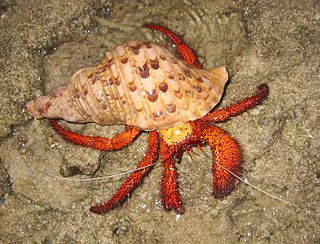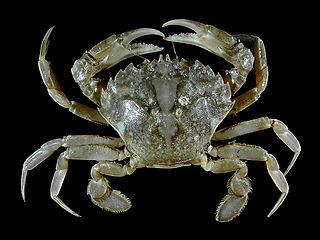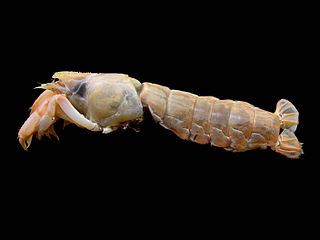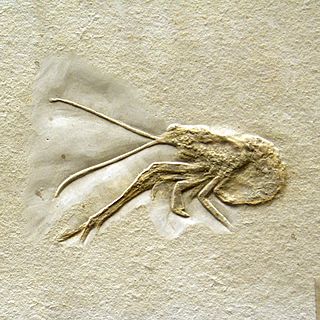 W
WThe Achelata is an infra-order of the decapod crustaceans, holding the spiny lobsters, slipper lobsters and their fossil relatives.
 W
WAnomura is a group of decapod crustaceans, including hermit crabs and others. Although the names of many anomurans include the word crab, all true crabs are in the sister group to the Anomura, the Brachyura.
 W
WThe Astacidea are a group of decapod crustaceans including lobsters, crayfish, and their close relatives.
 W
WAxiidea is an infraorder of decapod crustaceans. They are colloquially known as mud shrimp, ghost shrimp, or burrowing shrimp; however, these decapods are only distantly related to true shrimp. Axiidea and Gebiidea are divergent infraoders of the former infraorder Thalassinidea. These infraorders have converged ecologically and morphologically as burrowing forms. It is now widely believed that these two infraorders represent two distinct lineages separate from one another; however, this separation occurred in 2009 based on molecular evidence. As a result, much of the literature and research surrounding these infraorders still refers to the Axiidea and Gebiidea in combination as "thalassinidean" for the sake of clarity and reference. This division based on molecular evidence is consistent with the groupings proposed by Robert Gurney in 1938 based on larval developmental stages.
 W
WCrabs are decapod crustaceans of the infraorder Brachyura, which typically have a very short projecting "tail" (abdomen), usually hidden entirely under the thorax. They live in all the world's oceans, in fresh water, and on land, are generally covered with a thick exoskeleton, and have a single pair of pincers. Many other animals with similar names – such as hermit crabs, king crabs, porcelain crabs, horseshoe crabs, and crab lice – are not true crabs.
 W
WThe Caridea, commonly known as caridean shrimp, are an infraorder of shrimp within the order Decapoda. They are found widely around the world in both fresh and salt water.
 W
WCorophiida is an infraorder of amphipods that contains the two parvorders Caprellidira and Corophiidira.
 W
WGebiidea is an infraorder of decapod crustaceans, formerly classified in the Thalassinidea. It comprises the following families:Axianassidae Schmitt, 1924 Laomediidae Borradaile, 1903 Thalassinidae Latreille, 1831 Upogebiidae Borradaile, 1903
 W
WGlypheidea is an infra-order of decapod crustaceans, comprising a number of fossil forms and the two extant genera Neoglyphea and Laurentaeglyphea:
 W
WPolychelida is a group of decapod crustaceans. Fossil representatives are known dating from as far back as the Upper Triassic. A total of 38 extant species, all in the family Polychelidae, and 55 fossil species have been described.
 W
WThe Stenopodidea or boxer shrimps are a small group of decapod crustaceans. Often confused with shrimp or prawns, they are neither, but belong in a group closer to the reptant decapods, such as lobsters and crabs. They can be easily recognized by their third pereiopod, which is greatly enlarged, while for lobsters and crabs, it is the first pereiopod that is much bigger than the others. There are 71 extant species currently recognized, divided into 12 genera. Three fossil species are also recognized, each belonging to a separate genus. The earliest fossil assigned to the Stenopodidea is Devonostenopus pennsylvaniensis from the Devonian. Until D. pennsylvaniensis was discovered, the oldest known member of the group was Jilinicaris chinensis from the Late Cretaceous.Macromaxillocarididae Alvarez, Iliffe & Villalobos, 2006 Macromaxillocaris Alvarez, Iliffe & Villalobos, 2006 Spongicolidae Schram, 1986 Engystenopus Alcock & Anderson, 1894 Globospongicola Komai & Saito, 2006 Jilinicaris † Schram, Shen, Vonk & Taylor, 2000 Microprosthema Stimpson, 1860 Paraspongicola De Saint Laurent & Cléva, 1981 Spongicola De Haan, 1844 Spongicoloides Hansen, 1908 Spongiocaris Bruce & Baba, 1973 Stenopodidae Claus, 1872 Devonostenopus † Jones et al., 2014 Juxtastenopus Goy, 2010 Odontozona Holthuis, 1946 Phoenice † Garassino, 2001 Richardina A. Milne-Edwards, 1881 Stenopus Latreille, 1819
 W
WThalassinidea is a former infraorder of decapod crustaceans that live in burrows in muddy bottoms of the world's oceans. In Australian English, the littoral thalassinidean Trypaea australiensis is referred to as the yabby, frequently used as bait for estuarine fishing; elsewhere, however, they are poorly known, and as such have few vernacular names, "mud lobster" and "ghost shrimp" counting among them. The burrows made by thalassinideans are frequently preserved, and the fossil record of thalassinideans reaches back to the late Jurassic.